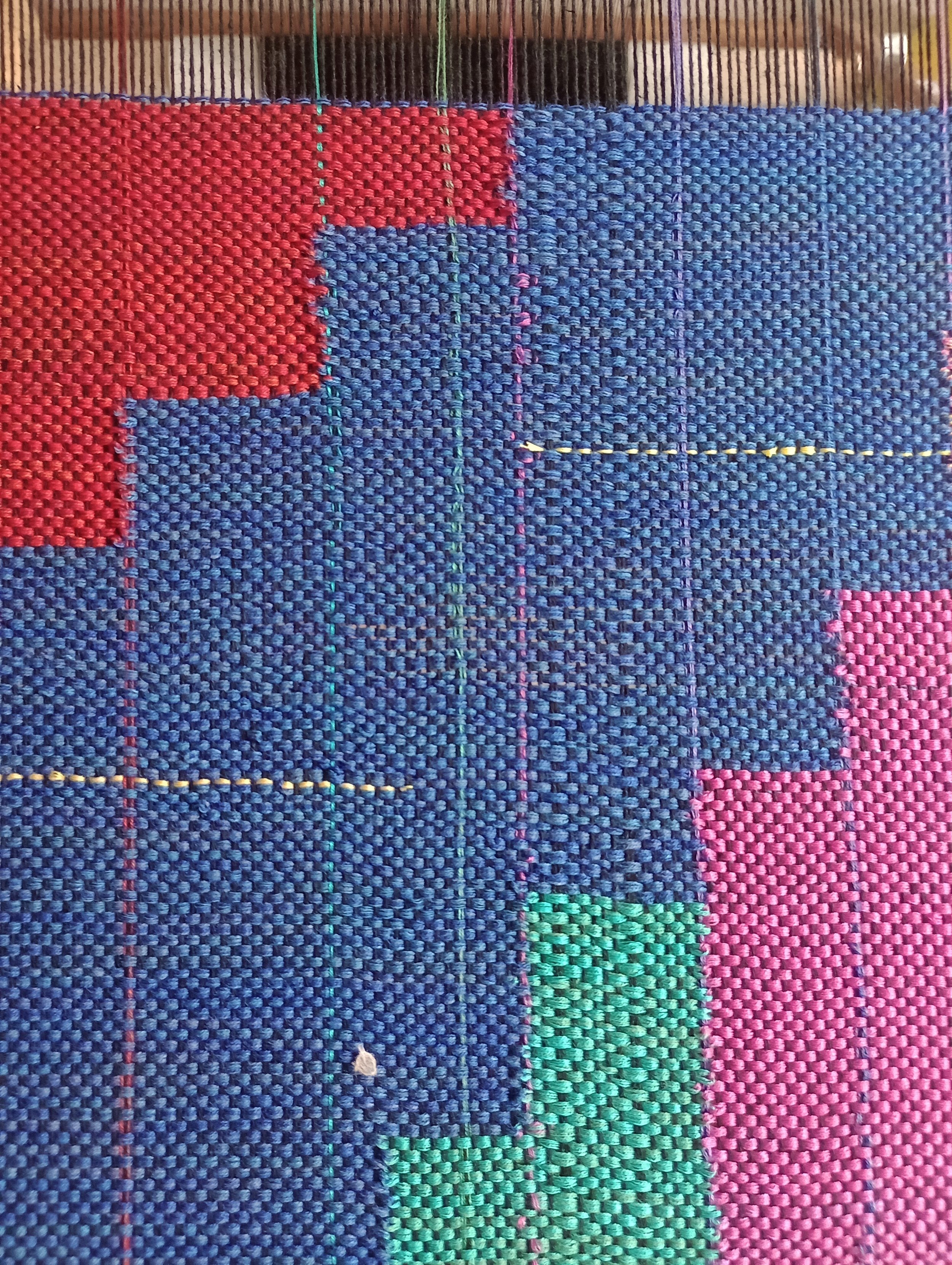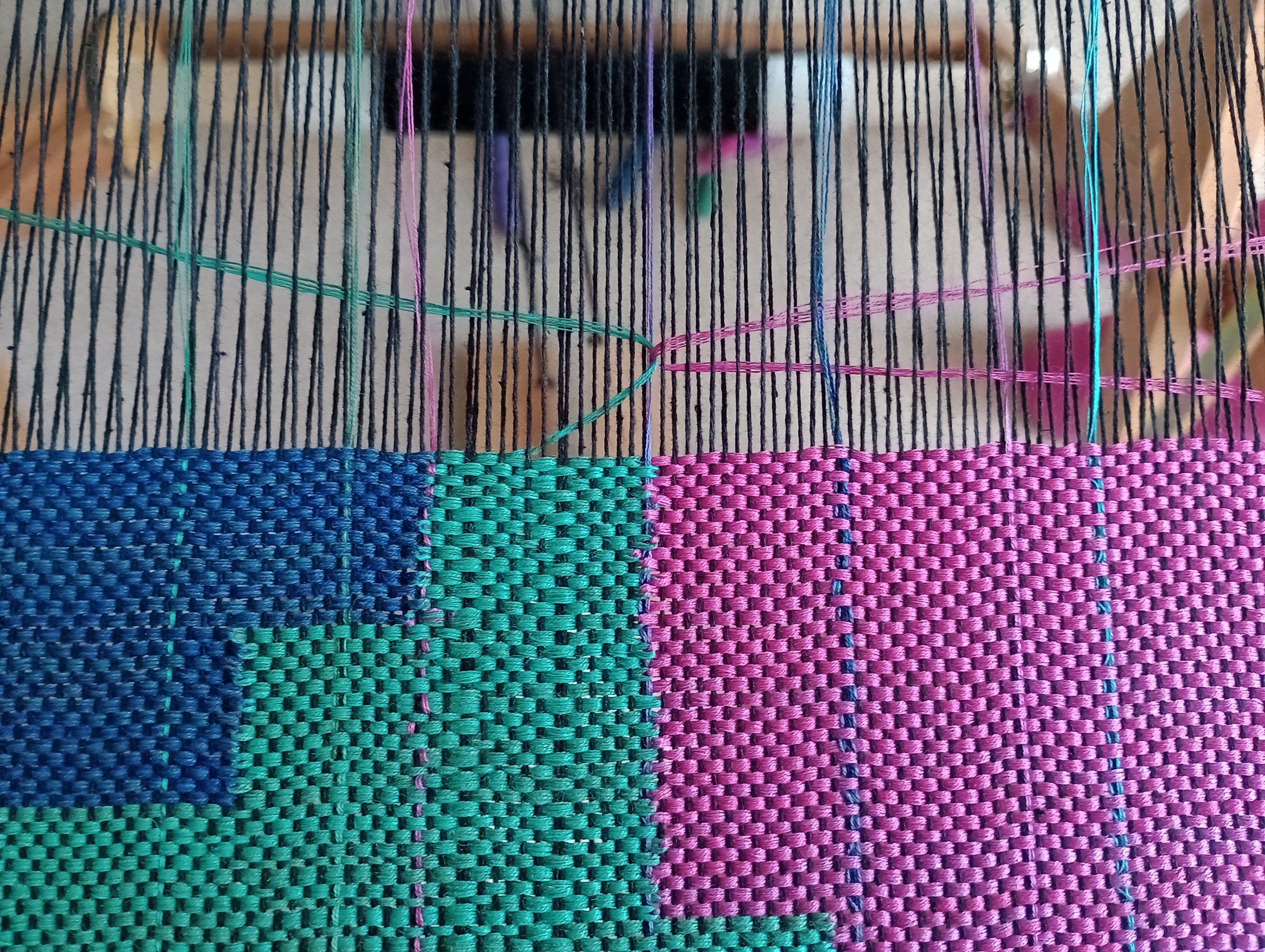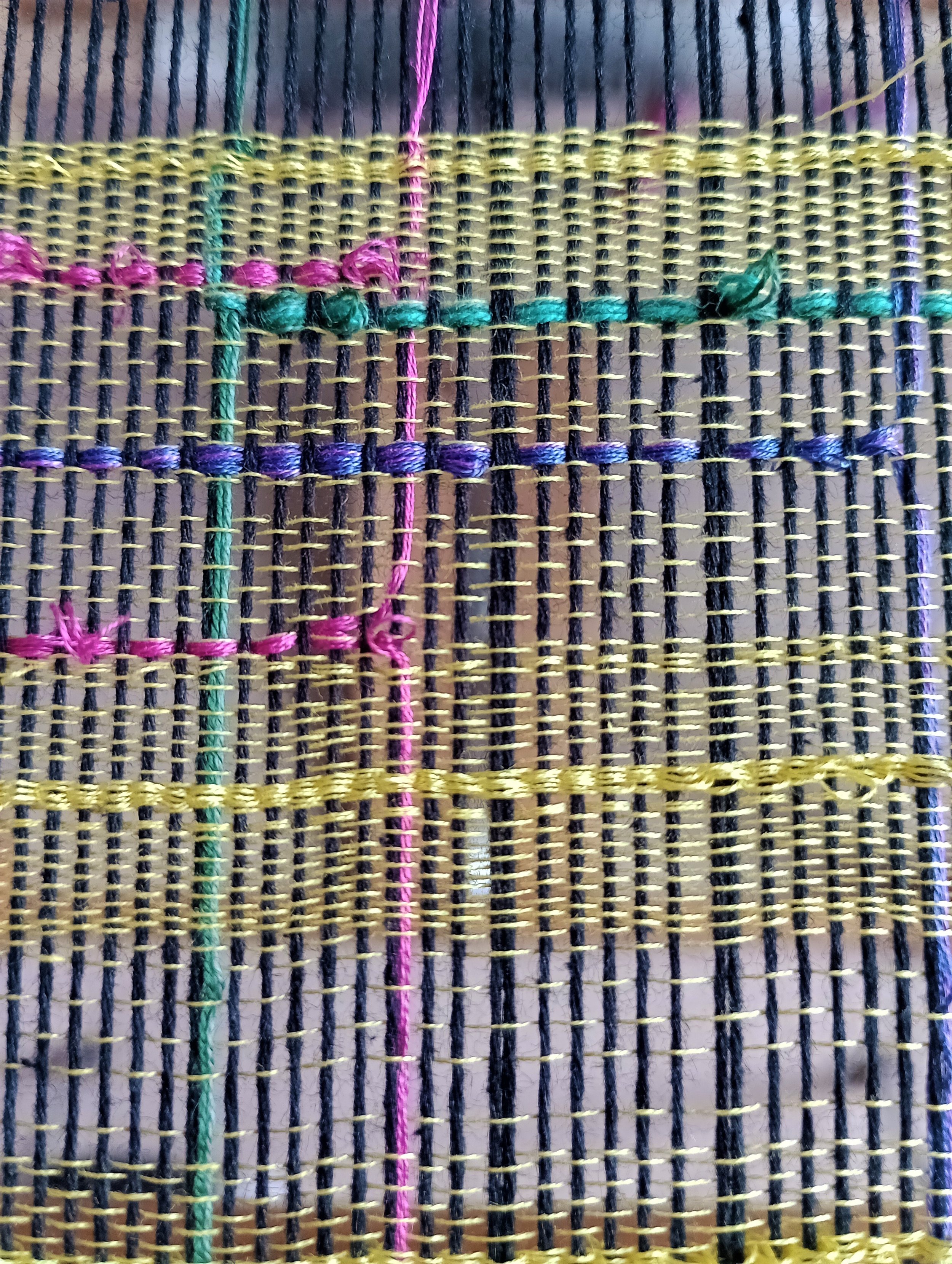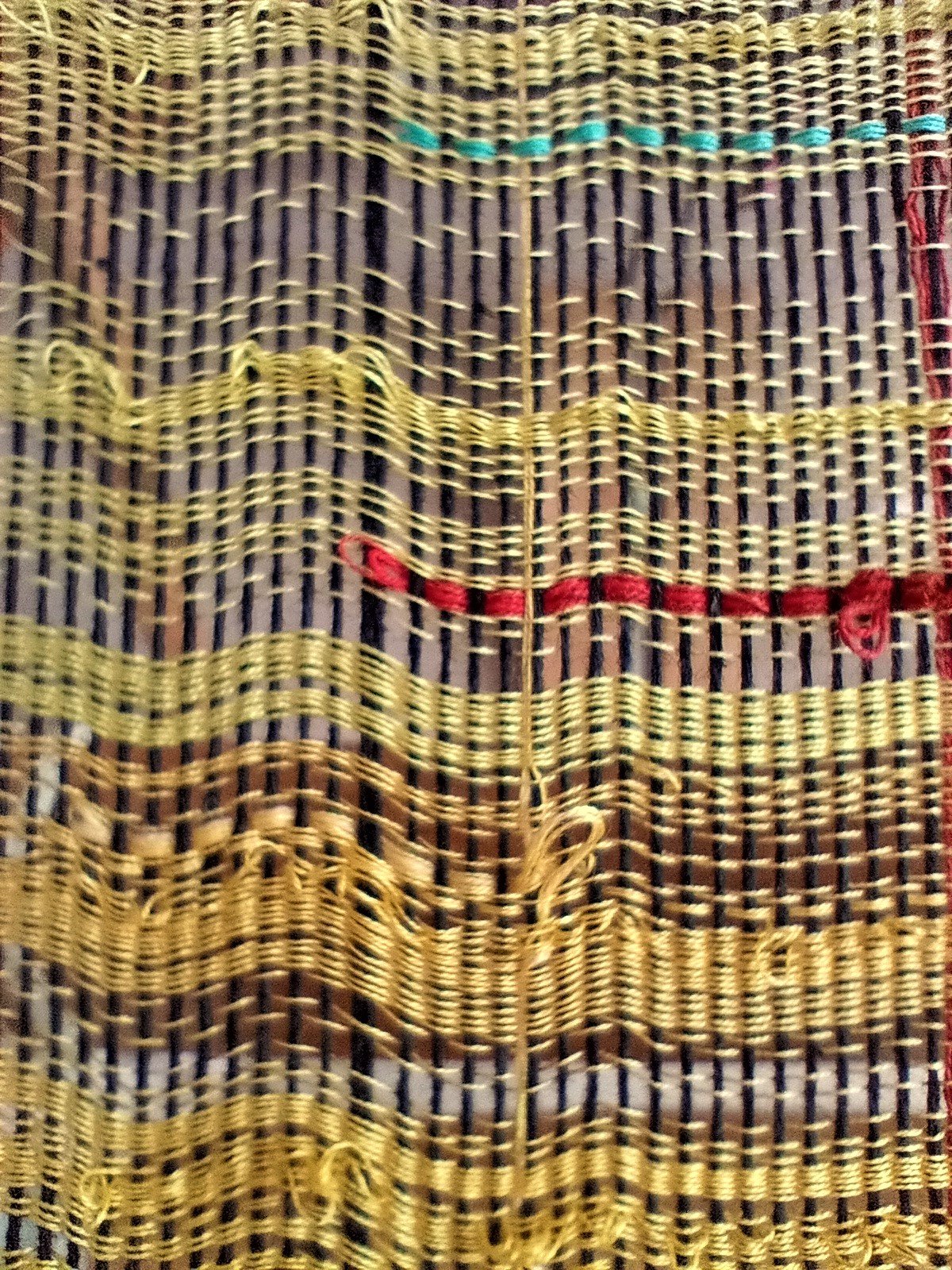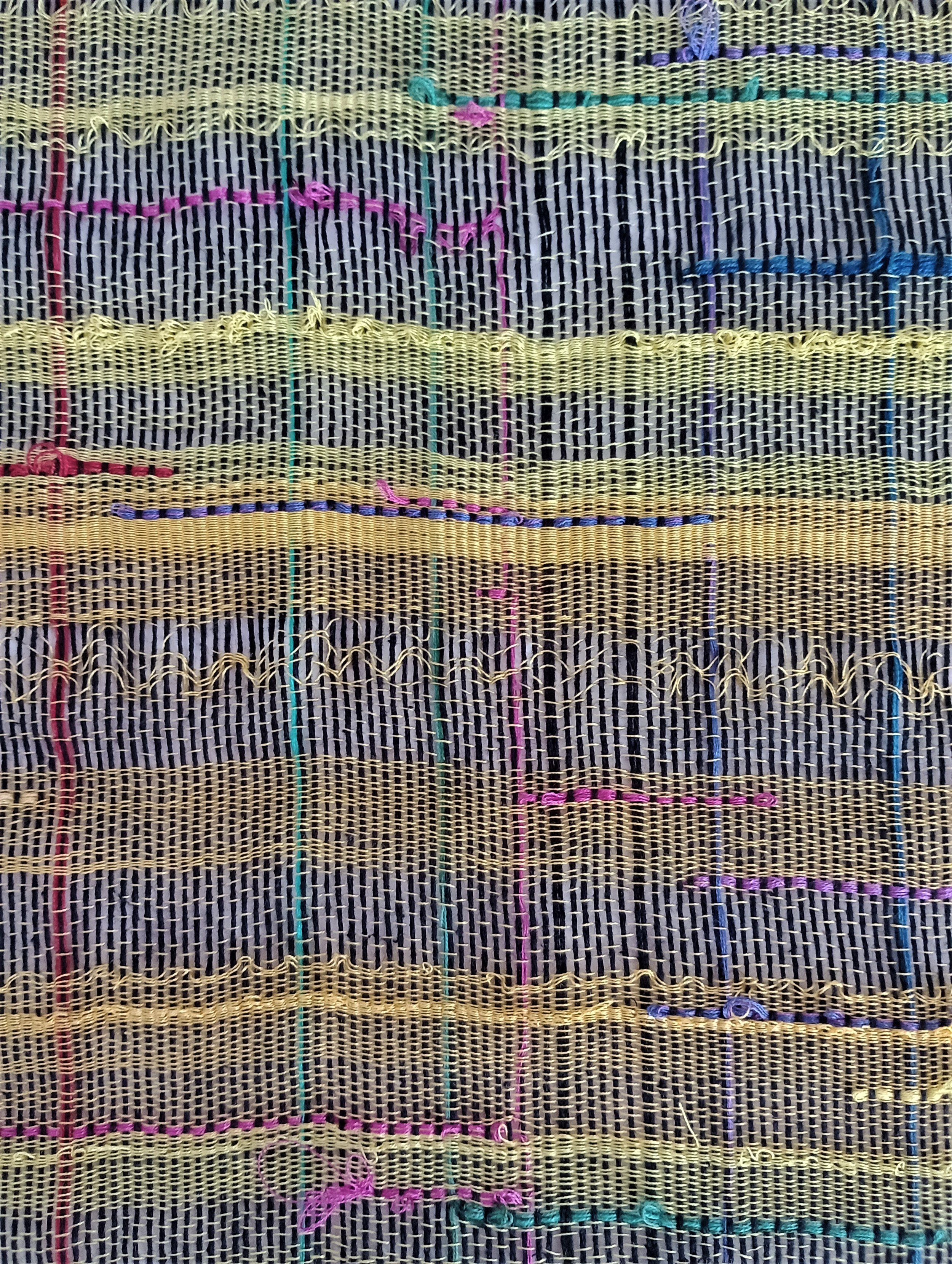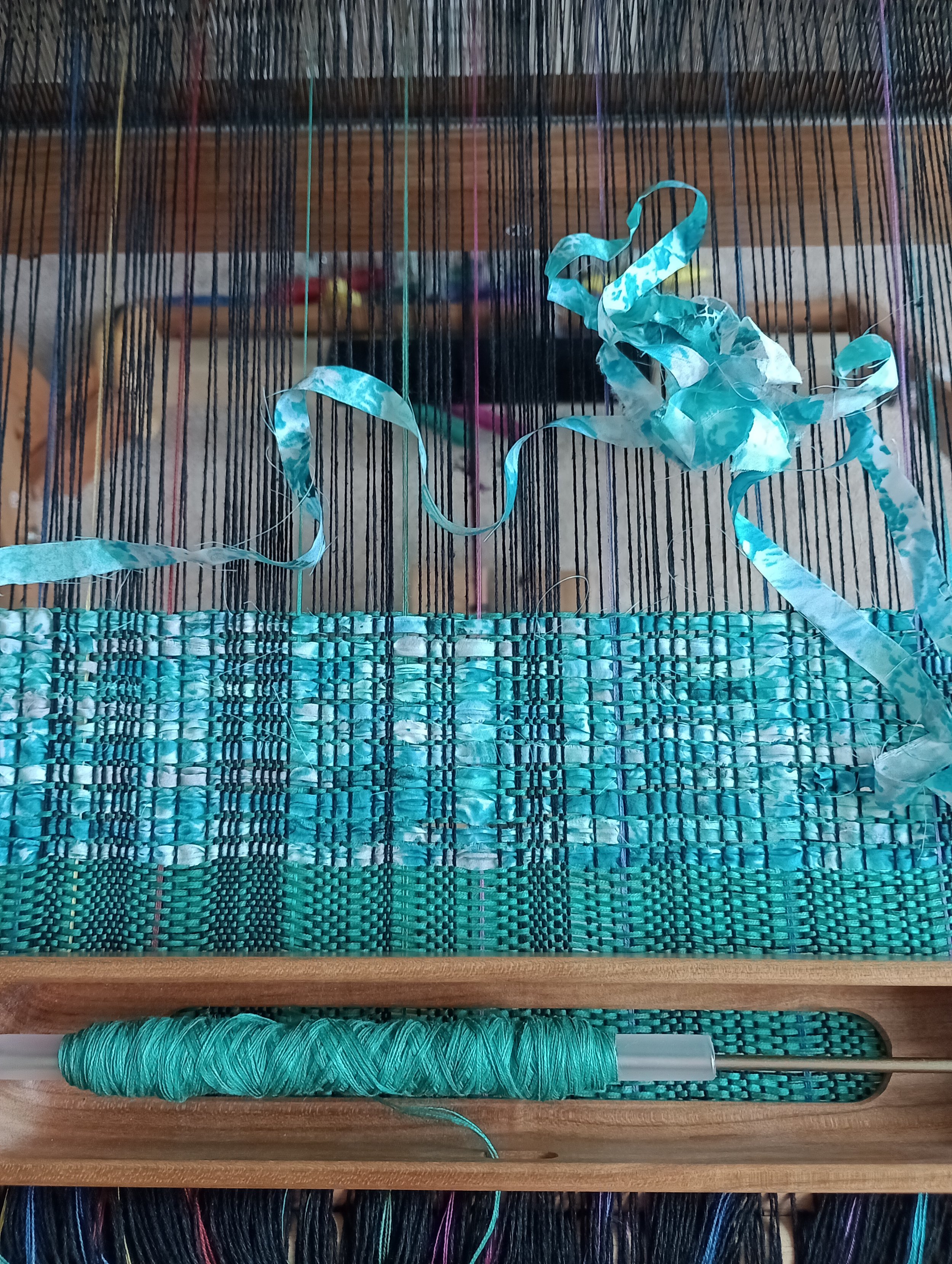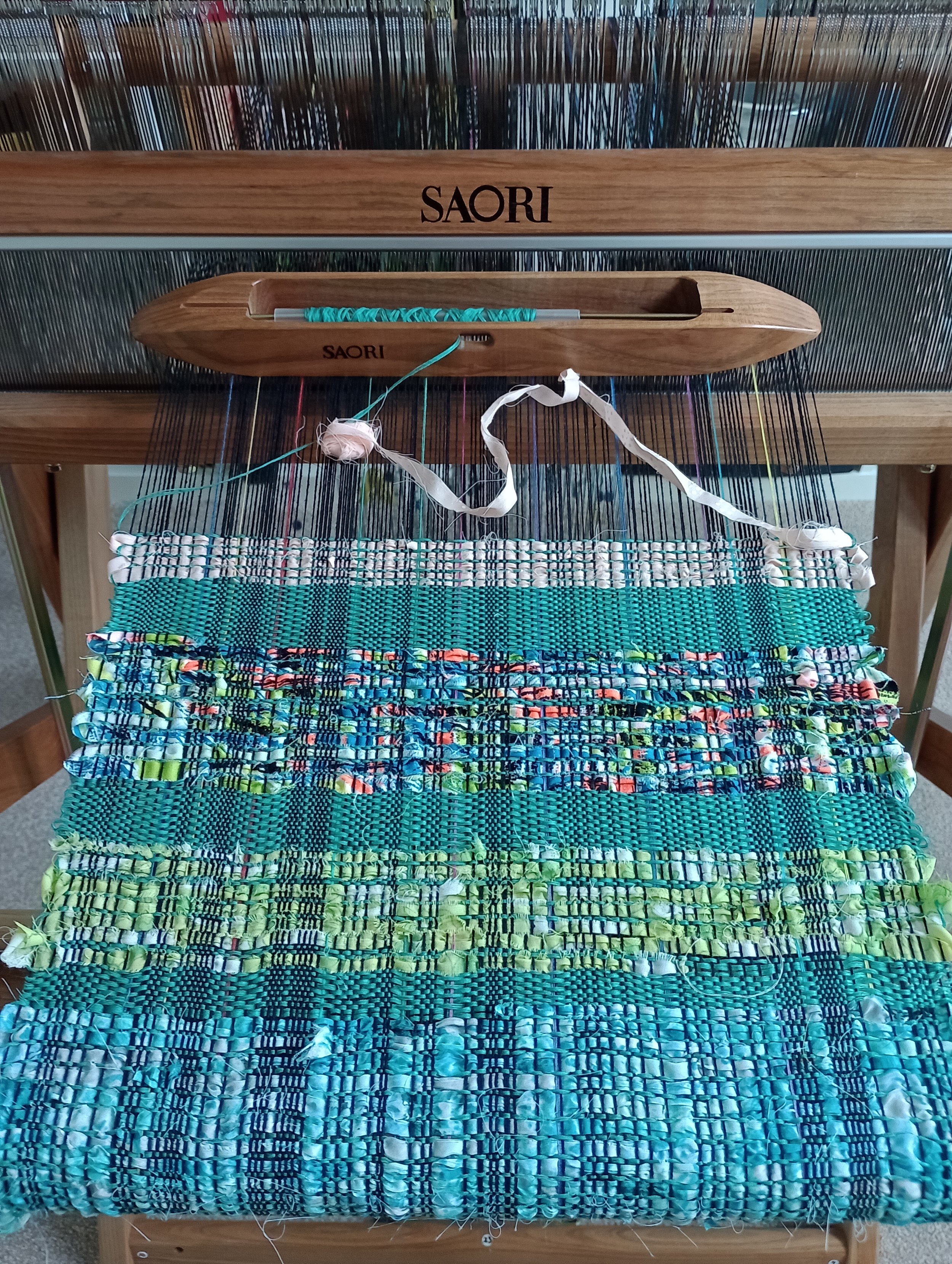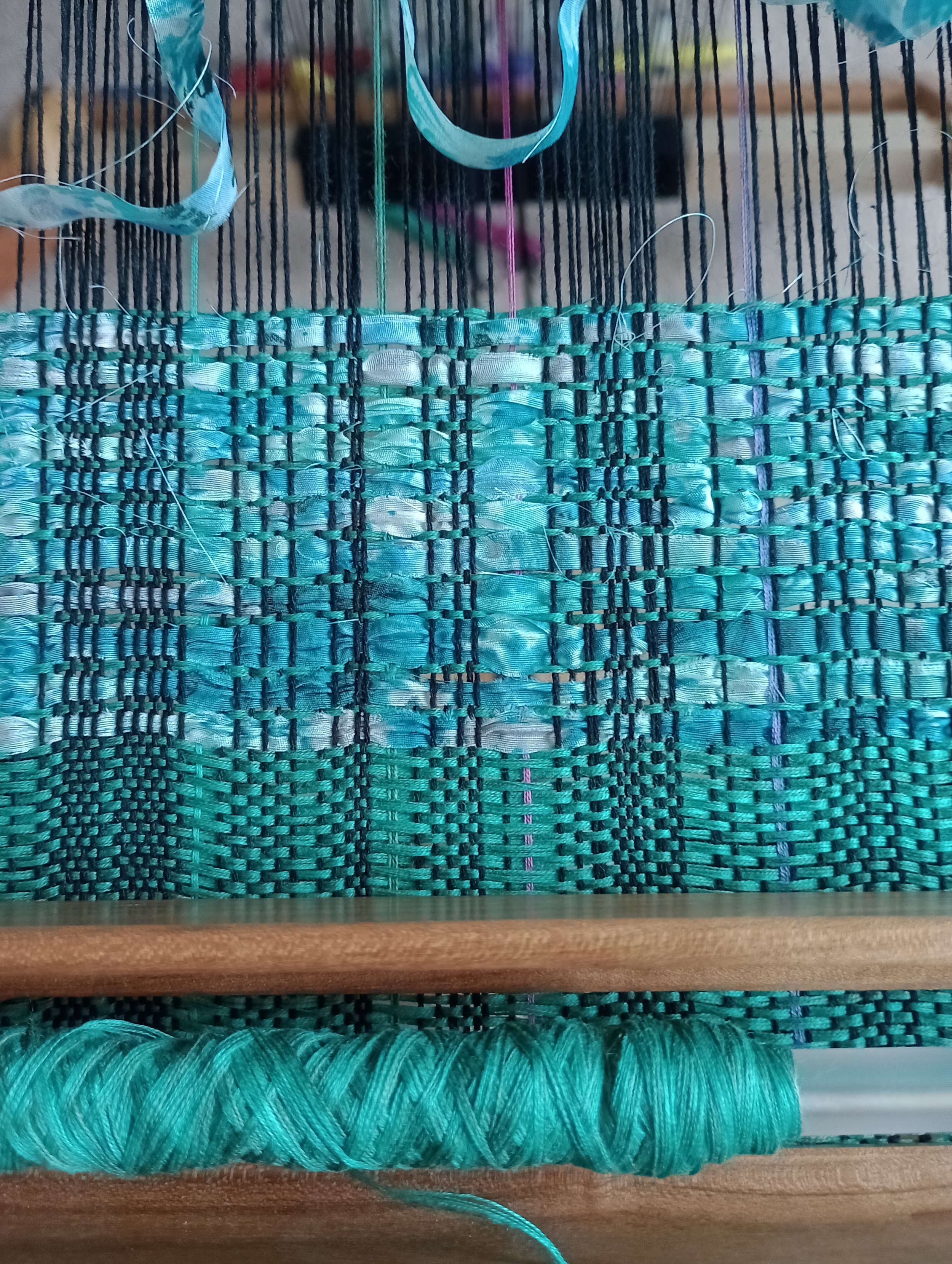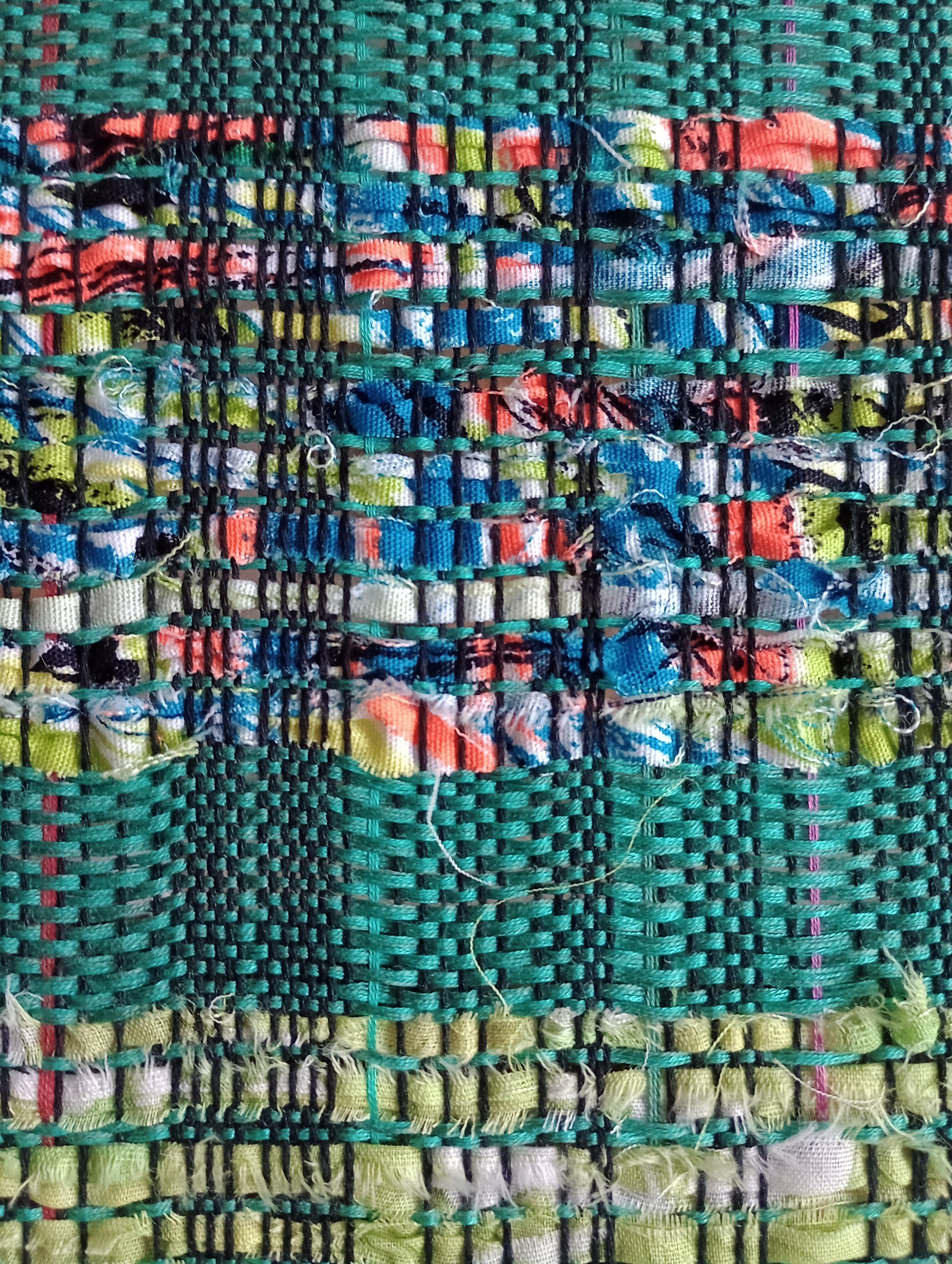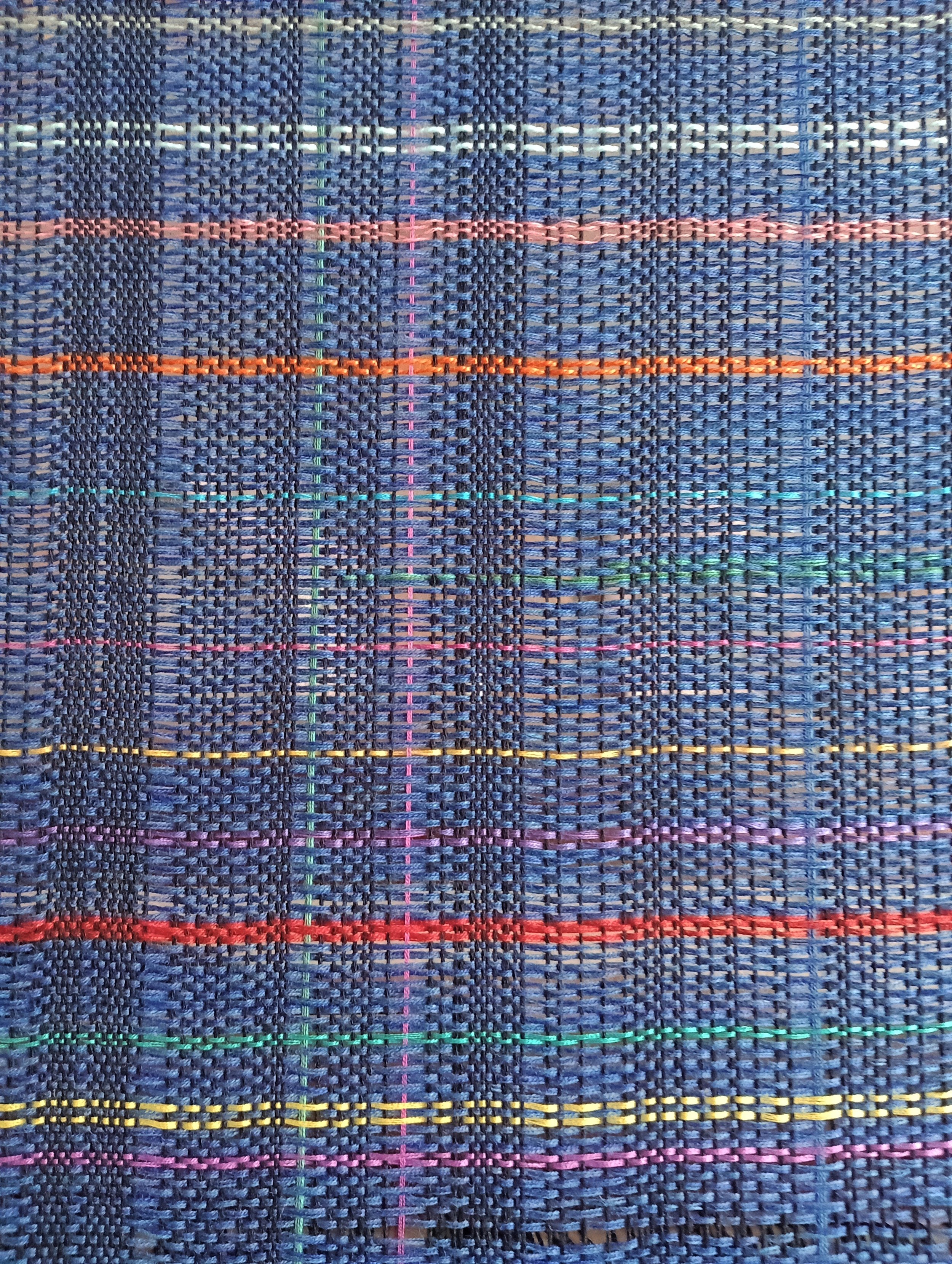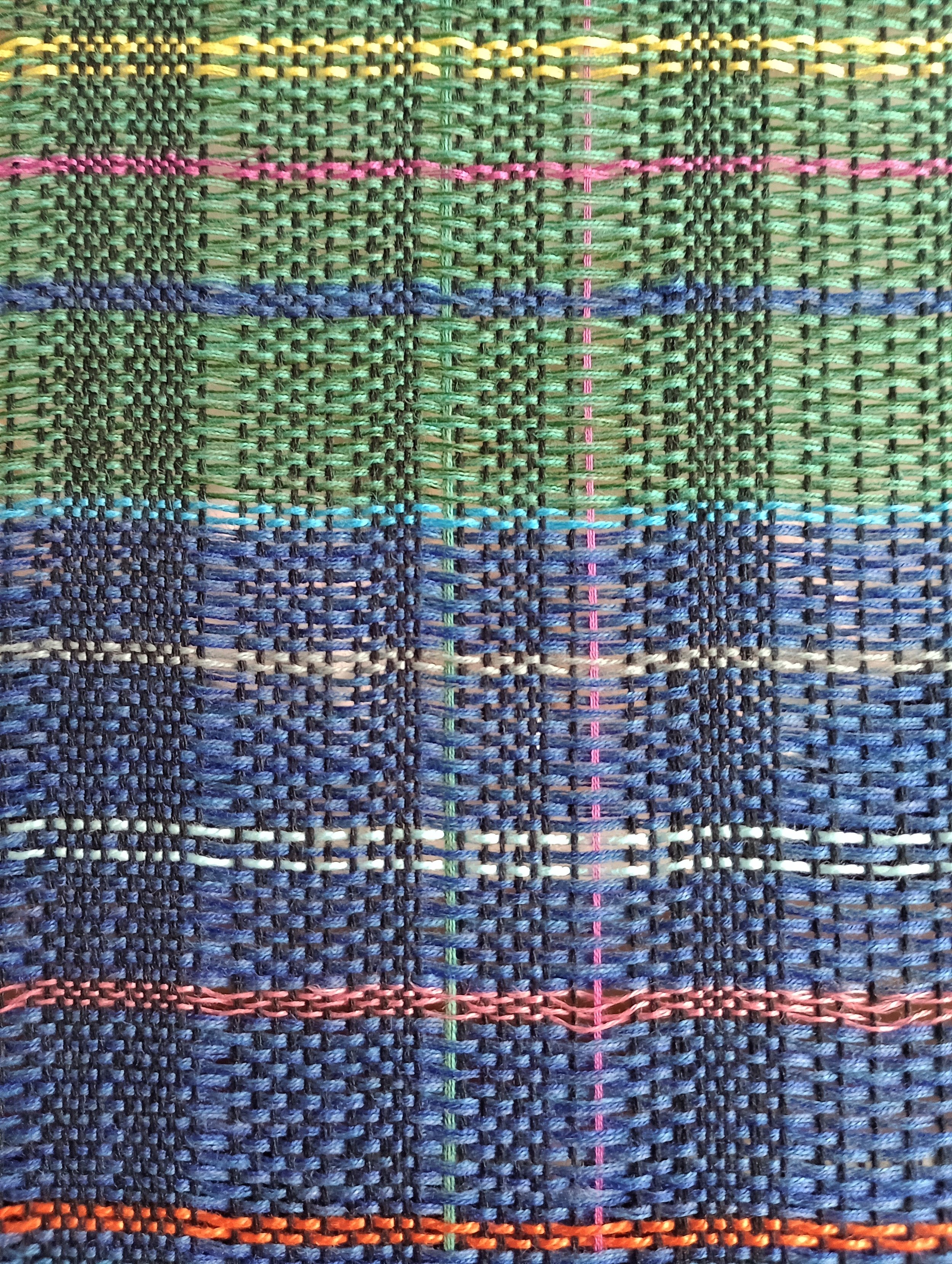Here is an update on how my weaving for my Intuitive Threads project has been progressing. Since my first piece that I wrote about in my last blog, I’ve woven three more pieces and continued to try out techniques, materials and colours. I’m not going to focus on the technical stuff in this post, I want to talk about the emotional and mental aspects of the creative process that have come up for me recently.
Difficult Second, Third and Fourth Woven Pieces
In my last blog I mentioned something I referred to as ‘the difficult second album’, that musicians often suffer with when under pressure to follow up the initial successful album. Can they recreate the conditions and the magic that made the first one successful? Can they perform under the pressure that wasn’t there when they were still unknown and had less external pressures on them to succeed?
Well now I’ve put it like that, I feel like I’m over exaggerating my weaving situation here, but certainly I felt something similar, if on a smaller stakes scale. I was really pleased with the first woven piece I created on my Saori loom. I felt free to experiment and follow through with the process I found myself in and was pleasantly surprised with the result. When it came to the second piece, I felt a pressure, albeit an internal one, to recreate or exceed that original success. So how would I do that? Well by using similar materials, yarns and techniques as before and adding additional techniques I’d learned from the workshops with Amanda at Beautiful Cloth Saori Studio
Moving Through Discomfort
At first, weaving this second piece felt really uncomfortable. Not surprising considering the pressure I was putting on myself to produce something ‘really good’. I realised I had a background belief that I needed to create a coherent collection. Perhaps this is because in the back of my mind I’ve been thinking I’d like to display these works as an exhibition at some point in the future or it could come from my original textile design training. Maybe it also relates to an underlying belief that I need to have a recognisable style as an artist. A recogonisable style or voice may be something that emerges with time, but it's unreasonable to expect it to show up on my second piece on the loom. Other feelings of discomfort that arose during the second and third pieces were dislike, boredom and impatience. Which brings me to…
Stages of Process
I realised I hadn’t been allowing for the different stages and phases of the creative process. After all, we don't all feel the same everyday. There are ebbs and flows; some days we are full of creative intention, inspiration and energy and others, we feel tired or uninspired. Sometimes creating does feel really good, when the energy is right and an idea is coming together, and there are times when it feels difficult, uncomfortable, boring and maybe a feeling of inertia, ‘stuckness’ as to what to do next. It's important to recognise all of these stages as part of the wider process and not to panic or to feel too bad about things when in a tricky stage. Time is an important factor here too. Sometimes we are impatient to push through and if things aren’t moving we can judge that harshly. However, creativity is an organic process, sometimes it needs a pause and it can’t be rushed.
The Importance of Play without Expectation and Allowing for Experimentation and Exploration
Another stage of the creative process that is important, and especially relevant to this project, is allowing time and space for experimentation. With that comes the element of play. With all the pressure I’d been putting on myself to create something ‘good’, I was overlooking an important element of both my project and the creative process. After trying different techniques and materials and working on my fourth woven piece, I realised the discomfort I was feeling because my weaving wasn’t forming a coherent collection was misplaced. I’m not at the coherent collection stage (if there will ever be one). I am at the stage of exploring a new practice of Saori weaving and learning through play and experimentation. Additionally Saori itself is a form of free weaving and that’s why I chose it to explore themes around intuition and self-expression. It is interesting how often I feel uncomfortable with this process when I am feeling discomfort about not having clear tangible outcomes in mind.
Replacing The Harsh Inner Critic with Reflection that Nurtures Growth and Development
Another cause of discomfort that came up is the feeling that what I’m weaving/creating is not ‘good enough’ in some way. That it’s not, and I’m not, creating something that is at least ‘quite good’ and ideally better. So, in creeps the voice of the ‘inner critic’ that says, this isn’t quite good enough, and implies that you should feel really bad about your failure to live up to undefined ideals and it might be best if you just gave up. My inner critic is not as loud as it once was, so it has found more sneaky, quieter ways to show up, in a way that it’s not always obvious that that’s what’s going on. Important then to reframe consciously - What is my inner critic trying to do? How can I navigate it better?
There is an element of protection in my inner critic. It is protecting me from the discomfort of feeling unsafe in new and experimental places. It’s softening the fear of failure (or success) with a reminder that I still have control. I can feel safe again through perfectionism and through pulling the plug, quitting at any time.
I think it’s important to recognise the value of having a critical internal voice in the creative process. It’s important to be able to reflect on creative choices and processes to evaluate and improve and make decisions about how to progress. But this voice needs to be one that evaluates fairly and usefully, not just shutting you down. A reflective inner voice that nurtures growth and development.
Unconscious Projection of Big Life Issues onto Smaller Fractals and Internal Pressures to See Signs of Success
Another cause of the discomfort I’ve been feeling through this creative exploration is this. I realised I was projecting my bigger life ‘stuff’, fears and hopes, onto my creative output. Although in theory I am providing myself with space to explore and ‘make mistakes’, internally I was projecting a desire for positive outcomes for my project and life decisions and need for it to work out well in a broader context, onto the smaller task of just doing some weaving. Perhaps there is a cognitive dissonance here where I’m telling myself this is not that big of a deal but internally it very much is. Anyway, this made me think of fractals, what’s happening on the macro is also happening on the micro level.
A Safe Container
The idea of creating a safe container or space to create and experiment came up for me. How do I do that for myself? This is an independent project and process that I’m working through. I don’t have anyone's expectations to meet other than my own. So what are the aspects that make creating feel ‘unsafe’? Well there is the aforementioned inner critic and unreasonable expectations as well as perhaps a fear of how this will be perceived by others. Will it be successful? Will it meet my own expectations of success?
So how do I create a space for myself with a bit more gentleness and kindness, with more acceptance and less judgement? How can I create the right environment emotionally and mentally for myself to truly allow more freedom of expression without self-censoring or criticism?
Freedom of Expression
This leads me onto the idea of having real freedom in expression. What does this really mean and what does it look and feel like? Personally I feel that I would like to reach a depth of self-expression that I never quite get to. It’s like I still have some internal limitations that self edit or block me from accessing something. Of course it’s difficult to describe exactly what because we are talking about intangibles and potentials. I feel there is the potential for a greater depth of self creative expression within me that is somehow blocked from really expressing through my artistic work.
Self-Expression Vs Intuition
This is an idea I think I will keep coming back to throughout this project. I initially wanted to focus on how intuition works in the creative process but what keeps coming up for me is this idea of self-expression. They are not the same thing so I need to work through what actually characterises each and where they overlap. This is important to clarify for myself to make sense of my own aims for the project and creative process.
Lessons from Journaling
I recently completed a module on journaling for the Diploma in coaching I’m studying. Some interesting parallels came up for me between journaling and the idea of creating and weaving from a more expressive and intuitive process. Whereas I often find myself stuck in really allowing this through my weaving process, I found it easier to access in writing. When I did a free writing exercise of expressing whatever came to mind for 15 minutes, I found this easier to do. Even though beforehand I was worried about what I would write and uncomfortable about not knowing what or if any words would come out, I found that they did. This happened in the other journaling tasks I tried, even when I attempted more creative writing tasks. I took this as a lesson to apply a similar mindset to my weaving process. Being more allowing and accepting of whatever content emerges perhaps.
Language Vs Visual Expression
This led me to considering what is this difference between expression and intuition that comes through in written language and that which expresses through visual processes. I found it easier to connect to my thoughts through writing, even when some of these were partially unconscious thoughts before the writing process. When creating visually, expression comes in the form of imagery, colour, texture. Things which are less concrete, more open to interpretation but also perhaps more connected to emotion and unconscious feelings.
Summing Up
During the time it’s taken me to write this post, I completed the first warp on my Saori loom, threaded up the loom with a new warp and started weaving. From here my process is is about navigating what comes up for me as the next progression in my weaving. Ironically, the conclusion I’ve come to from all of this thought process, is that to really embrace a process of weaving that encompasses an intuitive and expressive approach, I need to think less, and do more!
Intuitive Threads is a personal research and development project by textile artist Amie Wiberley, Supported using public funding by Arts Council England.
If you would like to keep up to date with my progress throughout this project, please follow me on my blog and Social Media; Instagram @ameswibs, Twitter @amiwib, Facebook Amie Wiberley Textile Artist
Amie is a textile artist and holistic and creativity coach. Find out more at www.amiewiberley.co.uk. Sign up to the mailing list here.
